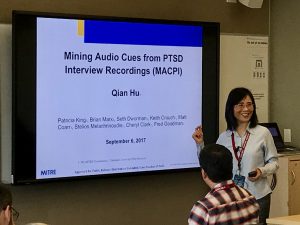
News
Interview with an Expert in Computational Linguistics – Dr. Qian Hu
What do startups, computational linguistics, Artificial Intelligence, and MITRE have in common? Meet Dr. Qian Hu, a scientist, collaborator, and mentor that has contributed greatly to these areas during her 20 years at MITRE.
Background
Dr. Hu grew up in China and completed graduate education in the US. With language always being an interest, Dr. Hu turned to computational linguistics. This led to speech technologies including automatic speech recognition, spoken language recognition, speaker identification, and speech synthesis. Later, this developed into voice biometrics for authentication and detection of vocal markers that are indicative of cognitive and mental state.
Multi-Disciplinary Impact at MITRE
During Dr. Hu’s first year at MITRE she pitched an idea for MITRE Sponsored Research (MSR), which is now called the MITRE Innovation Program (MIP). This led to more and more research and development of speech technologies and Natural Language Processing for cross-lingual multimedia information retrieval capabilities. In addition to transferring technology to MITRE’s government sponsors and development of MITRE work programs, this MSR yielded journal publications, a book chapter, and a US Patent “System and Method for Audio Hot Spotting”. She noted that MITRE is a unique place, having concrete problems from government that technology, research, and techniques can be applied against. “MITRE is in a unique position,” she says. “We are not in a competition with industry. Instead, we can leverage the best out of industry and academia and develop new capabilities to fill in the gaps between what’s out there and what our sponsors need.” This is a great opportunity, and is the way that MITRE makes a differentiated impact. MITRE can have broad impact with many technologies while bringing subject matter experts together from different domains. This kind of describes my experience working here; a lot of collaboration in conducting applied research and rapid capability prototyping. Identifying the technical gaps and developing algorithms and new capabilities addressing the gaps for our sponsor needs, so we can give something back. Multi-disciplinary approach and collaboration with domain experts can create something unique and much needed to solve real problems.”
Collaborating with Experts
Describing her experience using voice to detect certain conditions, Dr. Hu said, “Voice is an important indicator in the way we think and feel. It is an indicator of our mental and our cognitive state. People with extreme depression may talk very differently not only reflected by spoken words but also by vocal characteristics. We research and develop AI-enabled models to identify vocal markers indicative of certain emotional and mental states. Speech isn’t the only key to detect the state of the psychological condition, but it can be an indicator.” In describing some of her interactions Dr. Hu said, “I collaborate with experts inside and outside MITRE. Because of the work we’ve been able to do (patents, algorithms license to big companies), we’ve been able to build a reputation. Our government sponsors turn to us with challenges and needs.”
Pushing the Technical Boundaries  Dr. Hu describes how she and others are innovating by applying leading edge technology to challenges like detecting post-traumatic stress disorder (PTSD): “In the past few years and even during the pandemic, we have submitted two patents in this field. One is mining audio cues from PTSD interview recordings. This capability process and analyzes PTSD interview recordings and detect features from both voice and spoken words that are associated with diagnostic symptoms of PTSD. They can correlate question and response, speech rate, vocal characteristics, speech, emotional state. We have access to valuable data. It’s an ideal scientific data set, to analyze the data, train different models from different sources of material. [The] second patent pending is a human machined partnered prediction of PTSD; a clinician support tool. It allows them to select the source of information they want to use, assign a weight, and apply different models in the predictive analysis. These two technologies have primarily been working with the VA. This technology can be adapted to apply to servicemembers in any branch.”
Dr. Hu describes how she and others are innovating by applying leading edge technology to challenges like detecting post-traumatic stress disorder (PTSD): “In the past few years and even during the pandemic, we have submitted two patents in this field. One is mining audio cues from PTSD interview recordings. This capability process and analyzes PTSD interview recordings and detect features from both voice and spoken words that are associated with diagnostic symptoms of PTSD. They can correlate question and response, speech rate, vocal characteristics, speech, emotional state. We have access to valuable data. It’s an ideal scientific data set, to analyze the data, train different models from different sources of material. [The] second patent pending is a human machined partnered prediction of PTSD; a clinician support tool. It allows them to select the source of information they want to use, assign a weight, and apply different models in the predictive analysis. These two technologies have primarily been working with the VA. This technology can be adapted to apply to servicemembers in any branch.”
Engaging with Startups through Bridging Innovation
Speaking about startups, Dr. Hu said that “MITRE’s Bridging Innovation has put us in a position to really help those startup companies. Their CEOs are very enthusiastic. They know most of the capability need, but MITRE can help them with technical requirements, standards, the gap between the state-of-the-technology and our government sponsors’ need, and the technical approach. It puts [SMEs] in a very good position to help them, advise them, and to mentor for them to carve the successful path, so they can avoid mistakes and do the right thing. One side is the technical mentoring. The other is sharing the technology standard; what’s needed” Dr. Hu goes on to explain that another aspect of this guidance to startups is educating them on where the market is for the things they are building. “In some cases,” she says, “we can make connections, if the technology they are developing is mature enough and address our sponsors’ specific needs, where we introduce their technology to the sponsor…”.
MITRE Leadership’s Role in Accelerating Tech Transfer from MITRE Innovation Program
Dr. Hu mentioned being recruited to support Bridging Innovation engagements by Russ Graves and spoke highly of his vision and abilities to connect innovative technologies with customer needs: “He understands the spectrum of emerging technologies being developed at MITRE. He’s very familiar with the startup companies and what guidance they need to be successful.” Noting that Russ bridges the technology, MITRE SMEs, and the innovation programs outside of MITRE, Dr. Hu recalls being introduced to several companies, explaining that “MITRE is such a place where we have a forum for information to be exchanged.” An example of this was when Dave Moody, Director of Bedford Operations, invited her to present her research projects and prototype systems to a host of high-level visitors, to include senators and governors, president of universities, restating again MITRE’s strength in “technical exchange meetings.”
A “We Want to Help Attitude”
Dr. Hu highlighted “the spirit of all the MITRE people in the Bridging Innovation program.” “Everyone has such a warm and big heart”, she explains. A “we want to help attitude. That is so contagious.” Dr. Hu notes that working with Bridging Innovation can be rewarding. “Sharing our experience, know how, guidance, and connections, so we can make those companies deliver to the sponsor something more focused and faster.”
© 2021 The MITRE Corporation. All rights reserved. Approved for Public Release; Distribution Unlimited.
Case Number 20-02581-31
Click here for access to this article
